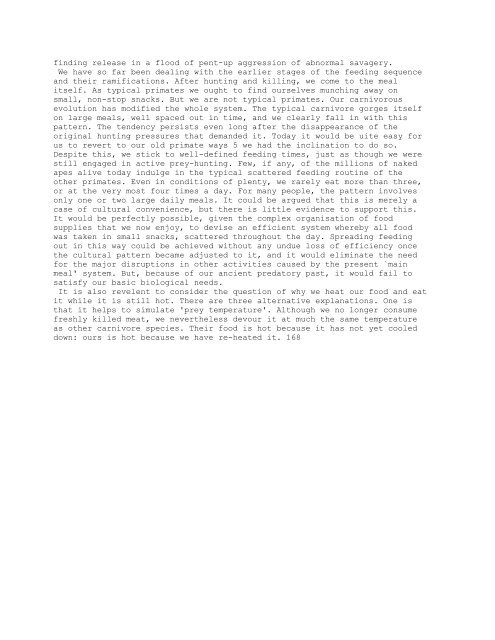Create successful ePaper yourself
Turn your PDF publications into a flip-book with our unique Google optimized e-Paper software.
finding release in a flood of pent-up aggression of abnormal savagery.<br />
We have so far been dealing with the earlier stages of the feeding sequence<br />
and their ramifications. After hunting and killing, we come to the meal<br />
itself. As typical primates we ought to find ourselves munching away on<br />
small, non-stop snacks. But we are not typical primates. Our carnivorous<br />
evolution has modified the whole system. The typical carnivore gorges itself<br />
on large meals, well spaced out in time, and we clearly fall in with this<br />
pattern. The tendency persists even long after the disappearance of the<br />
original hunting pressures that demanded it. Today it would be uite easy for<br />
us to revert to our old primate ways 5 we had the inclination to do so.<br />
Despite this, we stick to well-defined feeding times, just as though we were<br />
still engaged in active prey-hunting. Few, if any, of the millions of naked<br />
apes alive today indulge in the typical scattered feeding routine of the<br />
other primates. Even in conditions of plenty, we rarely eat more than three,<br />
or at the very most four times a day. For many people, the pattern involves<br />
only one or two large daily meals. It could be argued that this is merely a<br />
case of cultural convenience, but there is little evidence to support this.<br />
It would be perfectly possible, given the complex organisation of food<br />
supplies that we now enjoy, to devise an efficient system whereby all food<br />
was taken in small snacks, scattered throughout the day. Spreading feeding<br />
out in this way could be achieved without any undue loss of efficiency once<br />
the cultural pattern became adjusted to it, and it would eliminate the need<br />
for the major disruptions in other activities caused by the present `main<br />
meal' system. But, because of our ancient predatory past, it would fail to<br />
satisfy our basic biological needs.<br />
It is also revelent to consider the question of why we heat our food and eat<br />
it while it is still hot. There are three alternative explanations. One is<br />
that it helps to simulate 'prey temperature'. Although we no longer consume<br />
freshly killed meat, we nevertheless devour it at much the same temperature<br />
as other carnivore species. Their food is hot because it has not yet cooled<br />
down: ours is hot because we have re-heated it. 168








